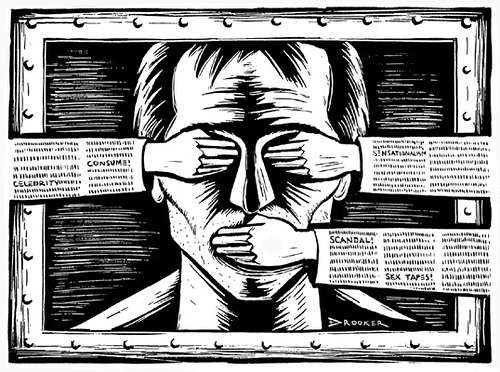
“Censorship” (cc) 2006 by Bill Kerr
Previously published at WGBHNews.org.
Talk is cheap. If President Trump actually followed through on his multifarious threats against the First Amendment, then those of us who report and comment on the news would already be on our way to a detention camp — a beautiful detention camp, for sure — somewhere in the empty spaces of Oklahoma.
He has, after all, threatened to undo the laws that protect journalists from frivolous libel suits. He has said that he would revoke Amazon’s (nonexistent) tax breaks in retaliation for the harsh coverage he’s gotten from The Washington Post, owned by Amazon chief executive Jeff Bezos. His attorney general, Jeff Sessions, has said that he may unleash a wave of subpoenas that would force reporters to identify anonymous leakers. And just recently, Trump demanded a Senate Intelligence Committee investigation into media organizations that report what he calls “fake news” and suggested that the broadcast licenses held by NBC should be revoked.
But Trump in theory and Trump in practice are two entirely different things. Though his anti-press rhetoric can be frightening at times, his follow-through has been pretty much nonexistent. Meanwhile, as First Amendment expert Jameel Jaffer says, Trump could legitimately if inadvertently lay claim to presiding over “the most transparent administration in history,” to invoke a solemn promise by Barack Obama that unfortunately preceded eight years of stonewalling on public records as well as an unprecedented crackdown on leakers.
“To say that the Trump administration leaks like a sieve would be very unfair to sieves,” Jaffer said Tuesday evening at the Harvard Kennedy School’s Shorenstein Center on Media, Politics and Public Policy. Moreover, Trump’s Twitter feed — he has tweeted more than 2,000 times since Election Day — offers a look into “the unvarnished presidential id,” Jaffer said, quoting Nixon biographer John Farrell.
Jaffer, currently the executive director of the Knight First Amendment Institute at Columbia University, had previously served as deputy legal director for the ACLU. His work on a lawsuit aimed at shaking loose documents from the George W. Bush administration resulted in the publication of the so-called torture memos — the legal rationale produced by the White House to justify waterboarding and other inhumane tactics used in questioning terrorism suspects.
Despite Jaffer’s backhanded praise for Trump, he is hardly sanguine. For one thing, he noted, Trump’s tweets come at us in such volume that they distract us and distort the public discourse. “We should be careful not to mistake noise for transparency,” he said. In addition, seeming openness in one realm is often used to mask efforts to cover up information elsewhere. For instance, the White House recently released an eight-minute video on its efforts to deal with the disastrous aftermath of Hurricane Maria in Puerto Rico while simultaneously removing statistics related to the relief effort from government websites.
Trump’s rhetorical attacks on the press — including his references to news organizations as “the enemy of the American people” — need to be taken seriously as well, Jaffer said. He called those attacks “an assault on transparency” aimed at undermining faith in the media, calling into question even “provable truths.” The effect, he said, is to replace journalists with Trump himself as the arbiter of what is true and false. And at least among his strongest supporters, he’s had some success. For instance, a Morning Consult/Politico poll released on Wednesday found that 46 percent of those surveyed “believe major news organizations fabricate stories about Trump.” That proportion rises to a stunning 76 percent among Republicans. (For a full breakdown, click here and turn to page 146.)
“If this is transparency at all,” Jaffer said, “it is transparency we should distrust and interrogate rather than applaud.”
My own fear — and I think Jaffer would agree — is that Trump has stirred up such hatred for the media (not that we were ever popular) that basic press protections could be in danger. Yes, you can believe that the courts will protect us; Trump’s Supreme Court justice, Neil Gorsuch, whatever his other shortcomings, seems as likely to support a robust First Amendment as his colleagues. But as Charles Pierce recently noted at Esquire.com, we are closer than you might think to the unthinkable prospect of a constitutional convention at which everything would be up for grabs, including the Bill of Rights. I do not assume that basic constitutional guarantees would survive in the current environment.
As I said, talk is cheap. But talk such as Trump’s cheapens the public discourse, giving people permission to indulge their hatreds and prejudices. We’re already seeing it happen.
At the end of Jaffer’s lecture, he was asked what makes him hopeful in this dark time. His response: The outpouring of protest against the racist violence in Charlottesville, Virginia, including tens of thousands of people in Boston who demonstrated against hate. “It’s a great relief to me to see people coalescing around this stuff,” he said.
So is Trump a threat or a menace to the First Amendment? I think it’s important to separate Trump’s words from his actions. To this point, at least, the president’s anti-media rhetoric has had no more effect than his attacks on Obamacare (dismantledlast Thursday; revived with his support on Tuesday), or his ever-shifting views on tax cuts. My philosophy: Keep a close ear out for what he says — but don’t panic until he actually does something.
Talk about this post on Facebook.
Discover more from Media Nation
Subscribe to get the latest posts to your email.
